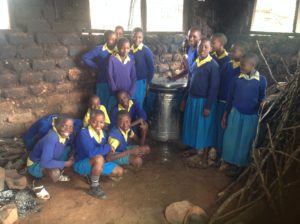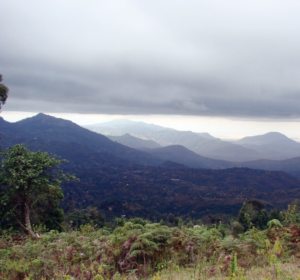
Firewood and charcoal are considered the two main sources of cooking fuel in most rural and urban areas in Kenya. Statistics from the Ministry of Energy indicate that more than 90 per cent of rural households use firewood for cooking and heating, while more than 80 per cent of urban households use charcoal. It is therefore not surprising that this demand for fuel wood is the one of the major drivers of deforestation in Kenya. As a result, forests and woodlands are rapidly being degraded, while biodiversity is seriously depleted and basic ecosystem services are being negatively affected particularly in areas with no formal protection such as Dakatcha Woodland and Taita Hills forests Important Bird and Biodiversity Areas (IBAs). Arabuko-Sokoke Forest IBA is another coastal forest that is under serious threat though it enjoys protected status.
The school feeding program initiated by national government as part of ensuring increased student enrolment and retention is one factor that is silently contributing to deforestation in rural areas. Given that most schools do not have woodlots to sustain their feeding programs or the capacity to purchase firewood, pressure is transferred to surrounding natural habitats. Left with few options, students are asked to bring to school sizeable pieces of firewood every day. In some schools, parents are required to supply firewood at the beginning of the term as part of their contribution to their children’s education.
A new conservation intervention may now offer a glimmer of hope for affected coastal forests, however. The adoption of “energy saving stoves”, which burn firewood more efficiently than traditional open fire of a three-stone stove, is taking shape in these areas. As an entry avenue in forest conservation, this initiative seeks to change community behavior and attitudes towards conservation through schools located adjacent to these forests.
The installation of school energy saving stoves in Taita, Dakatcha and Arabuko-Sokoke is being undertaken through the “Integrating Livelihoods and Conservation - People Partner with Nature for Sustainable Living” program. The program aims at enhancing participatory forest management and contributing towards improving livelihoods of the community in order to reduce pressure on forested IBAs. The program is being undertaken by Nature Kenya in partnership with DOF – the BirdLife Partner in Denmark with funding from the Danish International Development Agency (DANIDA) through CISU (Civil Society in Development). To date, three schools in Taita (All Saints Murughua, Vichwala and Mazola primary schools) have been installed with the energy saving stoves. Over 30 households have also been installed with the home version of the stoves.
Fuel Wood Use Calculation
On average a typical school has 400 students. If each student brings to school a piece of firewood weighing 2kg every school day this equates to 800kg of fuel wood brought to school daily. A school term runs for an average of 70 days. This translates to 56,000kg (56 tons) of fuel wood in use per term and 168 tons per year. According to a paper titled Wood to Energy: Sources and Supply by Langholtz et. al., an acre of pine plantation can produce three dry tons of fuel wood. Using this as the baseline, a school consuming 168 tons of fuel wood clears about 56 acres of forest or woodland annually. These 168 tons of dry wood are equivalent to 75,600kg of Carbon with a storage capacity of 98,823kg of Carbon Dioxide.
The “energy saving stoves” intervention seeks to significantly reduce fuel wood consumption by schools as a means of protecting forests. And the stoves are indeed living up to expectations. Tests conducted in Taita to determine their efficacy in reducing fuel wood consumption have yielded positive results. Water boiling tests were carried out in nine schools to establish the amount of firewood and cooking time consumed by the improved stoves and the traditional ones.
Encouraging Results
Results from the test showed that the energy saving stoves consumed over 60% less firewood compared to the traditional open fire stoves. Whereas open fire stoves used approximately 15kg of fuel wood to bring 30 liters of water to boil, the energy saving stoves only used 5kg! The energy saving stoves also took a shorter time to bring the water to boil, and produced less smoke.
The ongoing installation of energy saving stoves at the three sites is expected to benefit 15 schools by the end of 2017 and up to 3,000 households. It is hoped that use of these energy saving stoves will at least reduce pressure on Kenya’s shrinking coastal forests.
 Following the initial sightings of Hinde’s Babblers at the University of Nairobi’s Upper Kabete Field Station on 26th February (Simon Carter and David Guarnieri) and 8th March 2017 (Nature Kenya Wednesday Morning Bird Walk), marking the first official records of the species in Nairobi, I have been monitoring the birds as I am a student at UoN Upper Kabete Campus. On one occasion while observing the birds with Allan Kipruto (a schoolmate), we got a brief glimpse of what seemed to be a very orange-looking individual in the bushes where the rest of the Babblers (4 adults) were noisily moving around. We suspected it was a juvenile but couldn’t confirm since it quickly went deep into the bush and did not re-emerge.
Following the initial sightings of Hinde’s Babblers at the University of Nairobi’s Upper Kabete Field Station on 26th February (Simon Carter and David Guarnieri) and 8th March 2017 (Nature Kenya Wednesday Morning Bird Walk), marking the first official records of the species in Nairobi, I have been monitoring the birds as I am a student at UoN Upper Kabete Campus. On one occasion while observing the birds with Allan Kipruto (a schoolmate), we got a brief glimpse of what seemed to be a very orange-looking individual in the bushes where the rest of the Babblers (4 adults) were noisily moving around. We suspected it was a juvenile but couldn’t confirm since it quickly went deep into the bush and did not re-emerge.

